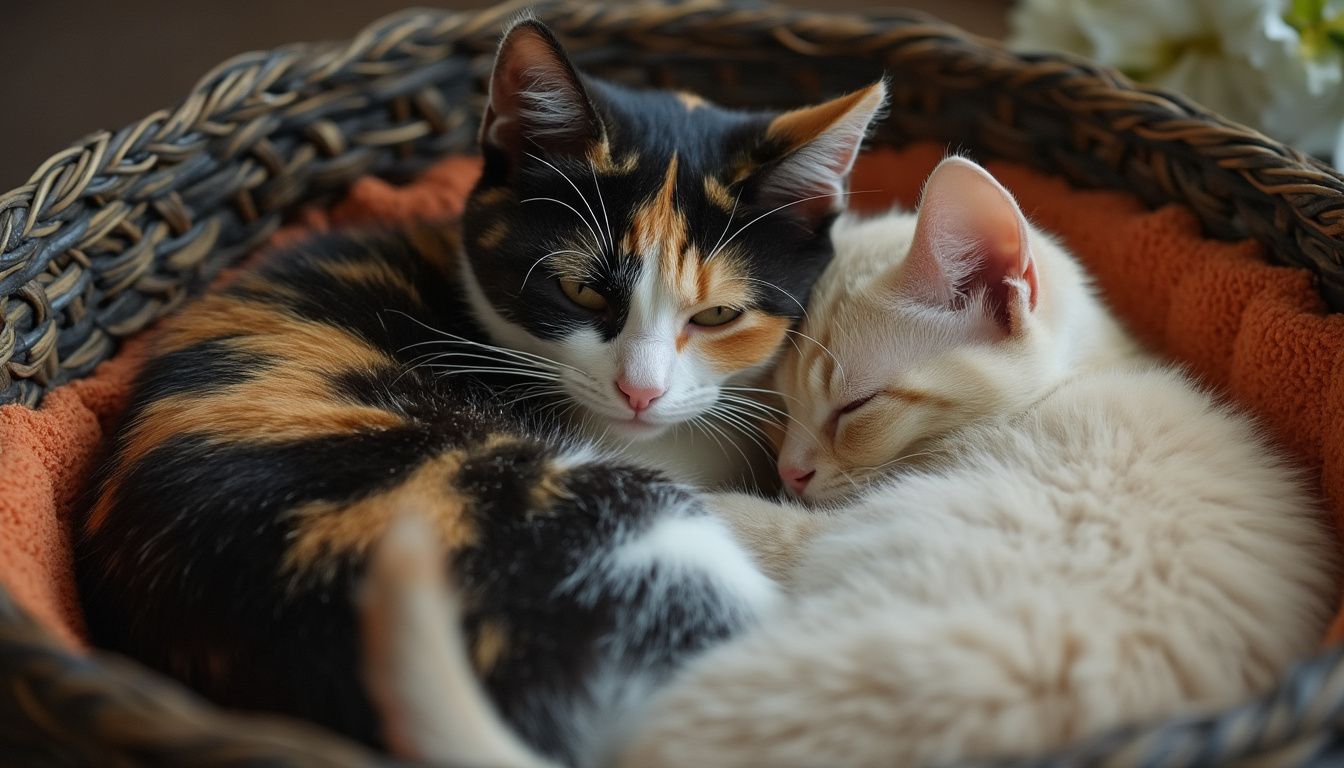
Bringing a feral cat into your home can feel like introducing a tornado to a calm summer day. You might wonder how to introduce a feral cat to a house cat without turning your living room into a feline wrestling ring.
The key? Patience, safety, and baby steps.
Cats are territorial creatures, so rushing the process could lead to hissing, swatting, or worse. Instead, think of this as a slow dance where both cats learn to trust each other—and you. With the right approach, you’ll soon see them sharing sunny spots and maybe even a cuddle or two. 😻
What You Need to Introduce a Feral Cat to a House Cat
Introducing a feral cat to your indoor cat requires ( a lot) preparation. Think of it as setting the stage for a slow but rewarding friendship. You’ll need the right supplies, a carefully arranged environment, and tools for scent swapping to make this process as smooth as possible.
Essential Supplies
Separate food and water bowls
Cats don’t like sharing their dining space, especially during an initial quarantine. Provide each cat with its own food and water bowls. This prevents territorial disputes and ensures both cats feel secure while eating.
Place the bowls in their respective areas to avoid unnecessary stress.
Litter boxes for each cat
Sharing a litter box is a no-go during the early stages. Set up a litter box for each cat in their separate spaces. This not only keeps things hygienic but also helps each cat establish its own territory.
A clean litter box can also reduce anxiety for both cats.
Toys, bedding, and scratching posts
Keep your cats entertained and comfortable with their own toys, bedding, and scratching posts. These items help them relax and provide an outlet for their energy. Plus, these can later be used for scent swapping, a crucial step in the introduction process.
Setting Up the Environment
A safe room for the feral cat
Start by creating a safe room for the feral cat. This separate room acts as their personal retreat during the initial quarantine. Equip it with all the essentials—food, water, a litter box, and cozy bedding.
This space allows the feral cat to adjust to indoor life without feeling overwhelmed.
Barriers like baby gates or cracked doors
Barriers are your best friend when it’s time for gradual introductions. Use baby gates or keep doors slightly cracked to let the cats see and smell each other without direct contact. This setup helps them get used to each other’s presence while maintaining a sense of security.
Tools for Scent Exchange
Blankets, toys, or towels for scent swapping
Scent swapping is a game-changer. Use soft items like blankets or toys that each cat has used. Swap these items between the two cats to introduce their scents non-threateningly. This method helps them associate the other’s scent with safety and comfort.
Feeding on opposite sides of a door
During the initial quarantine, feed the cats on opposite sides of a closed door. This combines scent swapping with a positive experience—food! Over time, they’ll start associating the other cat’s scent with something enjoyable.
Gradual territory swapping
Once both cats seem comfortable with scent swapping, try territory swapping. Let the feral cat explore the indoor cat’s space while the indoor cat checks out the safe room. This step helps them adjust to each other’s scent in a broader context.
Step-by-Step Guide on How to Introduce a Feral Cat to a House Cat
Why separate spaces are crucial
When introducing a feral cat to your home, separate spaces are non-negotiable. This setup ensures both cats feel secure during the initial stages. A safe room for the feral cat allows them to adjust to their new environment without feeling overwhelmed.
Meanwhile, your indoor cat can maintain their routine without the stress of an immediate encounter. Keeping them apart for at least a week helps reduce territorial disputes and gives each cat time to acclimate to the other’s presence.
Here’s why separate spaces matter:
-
The feral cat needs a closed-off area with food, water, and a litter box.
-
A safe room helps the new cat feel comfortable in their territory.
-
Your indoor cat gets time to adjust to the idea of a new housemate.
Setting up a safe room for the feral cat
Choose a quiet room, like a bathroom or spare bedroom, for the feral cat. Equip it with essentials: food, water, a litter box, and a cozy bed. Place the litter box and food on opposite sides of the room to avoid stress.
Add scratching posts, toys, and hiding spots to keep them entertained. Avoid inaccessible hiding places, as you’ll want to monitor their behavior.
Spend time in the room daily, talking softly or reading aloud to help them get used to your presence.
Step 2: Scent Exchange
Using bedding or toys to transfer scents
Scent swapping is the secret sauce of cat introductions. Use items like blankets or toys that each cat has used. Swap these between the two cats to familiarize them with each other’s scent. This step helps them associate the new smell with safety and comfort.
Observing reactions to each other’s scent
Pay close attention to how each cat reacts to the swapped items. Signs of curiosity, like sniffing or rubbing against the object, indicate progress. If either cat hisses or avoids the item, give them more time before moving to the next step. Patience is key here.
Step 3: Gradual Visual Introductions
Feeding on opposite sides of a closed door
Once both cats seem comfortable with scent swapping, start feeding them on opposite sides of a closed door. This combines the positive experience of eating with the presence of the other cat’s scent.
Over time, they’ll associate the smell with something enjoyable.
Using barriers like baby gates for safe viewing
When both cats show calm behavior, introduce visual contact using a barrier like a baby gate. This allows them to see each other without direct interaction. Look for relaxed body language, such as soft eyes or a gently swishing tail.
If either cat shows signs of stress, like hissing or swatting, take a step back and try again later.
Step 4: Supervised Meetings
Keeping initial meetings short and positive
The moment has arrived—your cats are ready for their first face-to-face meeting. Keep these initial encounters brief, like a quick coffee date rather than a full dinner party. Start by controlling first impressions.
Choose a neutral space where neither cat feels territorial. Use toys or treats to create a positive atmosphere. Let the cats see each other but avoid forcing interaction.
Supervise every second of these meetings. Be ready to step in if things get tense. Feed the cats near each other, but keep a safe distance. This helps them associate the other’s presence with something enjoyable.
If either cat shows signs of stress, such as hiding or puffing up their fur, end the session and try again later.
Watching for signs of stress or aggression
Cats are masters of body language, and their cues can tell you everything. Watch for wide eyes, stiff posture, or ears pinned back—these are red flags—loud vocalizations like growling or hissing signal discomfort.
Physical attempts to swat or bite mean it’s time to separate them immediately.
On the flip side, relaxed tails, soft blinks, and curious sniffing are signs of progress. Celebrate these small wins! Keep meetings short and sweet until both cats seem comfortable. This approach helps prevent confrontation and builds trust over time.
Step 5: Monitoring Behavior and Adjusting
Recognizing signs of progress or setbacks
Not every introduction will go smoothly, and that’s okay. Pay attention to how the cats behave after each meeting. Signs of progress include calm body language, shared curiosity, and reduced vocalizations.
Setbacks might look like increased hiding, aggression, or refusal to eat.
If you notice setbacks, slow down. Give both cats more time apart to decompress. Use scent swapping again to rebuild positive associations.
Remember, this isn’t a race—it’s a journey.
Adjusting the pace of introductions as needed
Every cat has its own timeline. Some may warm up quickly, while others need weeks or even months. Let the cats dictate the pace. If they seem relaxed, extend the length of their meetings.
Use toys or treats to redirect attention if one cat becomes overstimulated.
Always ensure both cats have escape routes during interactions. This gives them a sense of control and reduces stress. If progress stalls or aggression escalates, consider consulting a professional. Your goal is peaceful coexistence; sometimes expert advice can make all the difference.

Who Should Try This?
Cat Owners with a Feral Cat and an Indoor Cat
Understanding the challenges of feral cats
Introducing a feral cat to your indoor cat isn’t for the faint of heart. Feral cats come with their own set of quirks and challenges. Their age can make a big difference—kittens adapt faster, while older cats may take longer to warm up.
Expect some hurdles if the feral cat has had little to no human interaction. They might act out of fear, hide for days, or even hiss at the sight of you.
Temperament plays a huge role too. Some feral cats are naturally curious and bold, while others are shy and cautious. Health risks are another factor to consider. Feral cats may carry diseases that could affect your indoor cat.
A vet check-up is a must before you even think about introductions.
Assessing if your indoor cat is ready for a new companion
Your indoor cat’s personality matters just as much. Is your cat laid-back or easily stressed? Cats that are territorial or set in their ways might struggle with a new housemate. Look for signs that your cat is open to change.
Do they seem curious about other animals? Are they playful and social? If your cat already struggles with stress or anxiety, introducing a new cat might not be the best idea right now.
People Committed to Patience and Observation
Why patience is key to success
Patience isn’t just a virtue—it’s your secret weapon. Introducing a new cat, especially a feral one, takes time. Sometimes, it takes weeks. Other times, it takes years. You’ll need to move at the cats’ pace, not yours.
Rushing the process can lead to setbacks, stress, and even fights.
Think of it like planting a garden. You can’t rush a flower to bloom. You water it, give it sunlight, and wait. The same goes for your cats. Gradual acclimatization helps reduce stress and builds trust.
The importance of monitoring and adapting
Observation is your best friend during this process. Watch how both cats react at every stage. Are they curious or cautious? Do they seem stressed or relaxed? Adjust your approach based on their behavior. If one cat seems overwhelmed, slow down.
Successful introductions require flexibility. What works for one cat might not work for another. Be ready to adapt, whether that means extending scent-swapping time or reintroducing barriers.
Dedication, love, and a willingness to learn will help you create a peaceful home for both cats.
Potential Challenges When You Bring an Outside Cat Indoors
Bringing an outside cat indoors can feel like hosting a surprise guest who doesn’t know the house rules. Both your feral cat and indoor cat may face challenges as they adjust to this new arrangement. Understanding these hurdles will help you navigate the process with confidence.
Common Issues with Feral Cats
Fear and hiding behavior
Feral cats often act like secret agents when they first enter your home. They hide in corners, under furniture, or anywhere they feel safe. This behavior stems from fear and unfamiliarity with indoor life. You might notice them avoiding eye contact or freezing when approached.
Give them time and space to explore at their own pace. Providing cozy hiding spots can help them feel secure while they adjust.
Aggression or territorial disputes
Feral cats can become defensive when they feel threatened. Swatting, hissing, or even growling may occur as they establish their boundaries. Territorial disputes are common, especially if your indoor cat feels their space is being invaded.
Keep interactions controlled and gradual to prevent these conflicts from escalating.
Challenges with Indoor Cats
Resistance to change in routine
Indoor cats thrive on routine. A new cat disrupts their predictable world, leading to stress. You might see them retreating to safe spaces, refusing food, or avoiding the litter box. These behaviors signal discomfort and the need for reassurance.
Jealousy or stress from the new cat
Your indoor cat might act like a jealous sibling. Signs include dilated pupils, tail swishing, or loud vocalizations like hissing and growling. Some cats even resort to destructive behaviors, such as scratching furniture or marking territory outside the litter box.
Watch for these signs and address them promptly.
How to Overcome These Challenges
Using positive reinforcement
Positive association is your secret weapon. Reward both cats with treats or praise during calm interactions. Use toys to redirect their focus and create enjoyable experiences together. This approach helps them associate each other’s presence with good things, reducing tension over time.
Seeking professional help if needed
Sometimes, despite your best efforts, the cats may struggle to coexist peacefully. If aggression persists or stress levels remain high, consult a professional. A cat behaviorist can provide tailored strategies to resolve conflicts and ensure a harmonious home.
Remember, making life inside fun for your cat is key to their happiness and well-being.
Common Mistakes to Avoid When Introducing a New Cat
Rushing the Process
Why gradual steps are essential
Patience is your best ally when introducing a new cat. Cats thrive on routine and familiarity, so a slow introduction process helps them adjust without feeling threatened. Gradual steps allow both cats to build trust at their own pace.
This method reduces the chances of territorial disputes and stress-related behaviors. Think of it as building a friendship—forcing it never works.
The risks of forcing interactions
Rushing the process can backfire in several ways:
-
Aggressive behavior may erupt, putting both cats at risk of injury.
-
Stress can lead to health issues, such as loss of appetite or over-grooming.
-
Disease transmission becomes a real danger if the feral cat hasn’t been isolated and tested.
Take your time. Let the cats dictate the pace, and you’ll avoid these pitfalls.
Ignoring Signs of Stress
Recognizing body language and vocal cues
Cats are experts at expressing their emotions—if you know what to look for. Signs of stress include:
-
Wide eyes with dilated pupils
-
Ears pinned back
-
Puffed-up fur and tail
-
Stiff posture or tense facial muscles
-
Vocalizations like hissing, growling, or yowling
Some cats may hide or lash out when overwhelmed. Pay attention to these cues to gauge their comfort levels.
Addressing stress before it escalates
When you notice stress, act quickly. Separate the cats and give them time to decompress. Use calming tools like pheromone diffusers or soothing music. Reward calm behavior with treats or gentle praise. These steps help create a positive environment and prevent stress from escalating into aggression.
Not Providing Separate Resources
The importance of individual food, water, and litter areas
Sharing isn’t a concept cats embrace, especially during introductions. Each cat needs its own food, water, and litter box to feel secure. Separate resources prevent competition and reduce the likelihood of territorial disputes.
Preventing resource guarding and conflicts
When cats compete for resources, conflicts arise. One cat may guard the food bowl or litter box, leaving the other stressed and anxious. Providing individual resources ensures both cats feel safe and reduces tension. This simple step can make a world of difference in their adjustment period.
Introducing a feral cat to your indoor cat might feel like solving a feline puzzle, but you’ve got this! Start with preparation—separate spaces, scent swapping, and gradual introductions. Monitor their behavior like a detective, looking for signs of progress or stress.
Adjust your approach as needed.
Patience is your superpower here. Every cat has its own timeline, so let them set the pace. If things get tricky, don’t hesitate to call in a pro. Your goal is a happy, peaceful home for both cats. With love and persistence, you’ll get there! 🐾
FAQ
How long does it take to introduce a feral cat to an indoor cat?
The timeline varies. Some cats adjust in weeks, while others take months. Let the cats set the pace. Rushing can lead to setbacks. Patience and observation are your best tools for success.
Can I skip the scent-swapping step?
Nope! Scent swapping is crucial. Cats rely on smell to identify friends or foes. Skipping this step could lead to unnecessary tension. Use toys, blankets, or bedding to make this process smooth and stress-free.
What if the cats never get along?
Not all cats become best friends. Some may only tolerate each other. If aggression persists, consult a cat behaviorist. Your goal is peaceful coexistence, not forced friendship.
Should I let the feral cat roam freely right away?
Definitely not! Start with a safe room. Gradual introductions help the feral cat adjust to indoor life and your house cat. Free roaming too soon can overwhelm both cats and lead to conflicts.
How do I know if my cats are ready for face-to-face meetings?
Look for calm behavior. Signs include relaxed tails, soft blinks, and curiosity. Avoid meetings if either cat shows stress, like hissing or hiding. Always supervise their first interactions to ensure safety.

In her previous life, Lisa traveled extensively, both for work and leisure. After the pandemic struck, Lisa locked up her luggage and adopted a cat ever since.
Lisa is now an avid cat lover, she devotes most of her free time serving as butler to her adorable feline at home. When she is not with her cat, she can be seen using her phone sourcing for the latest cat supplies online.


